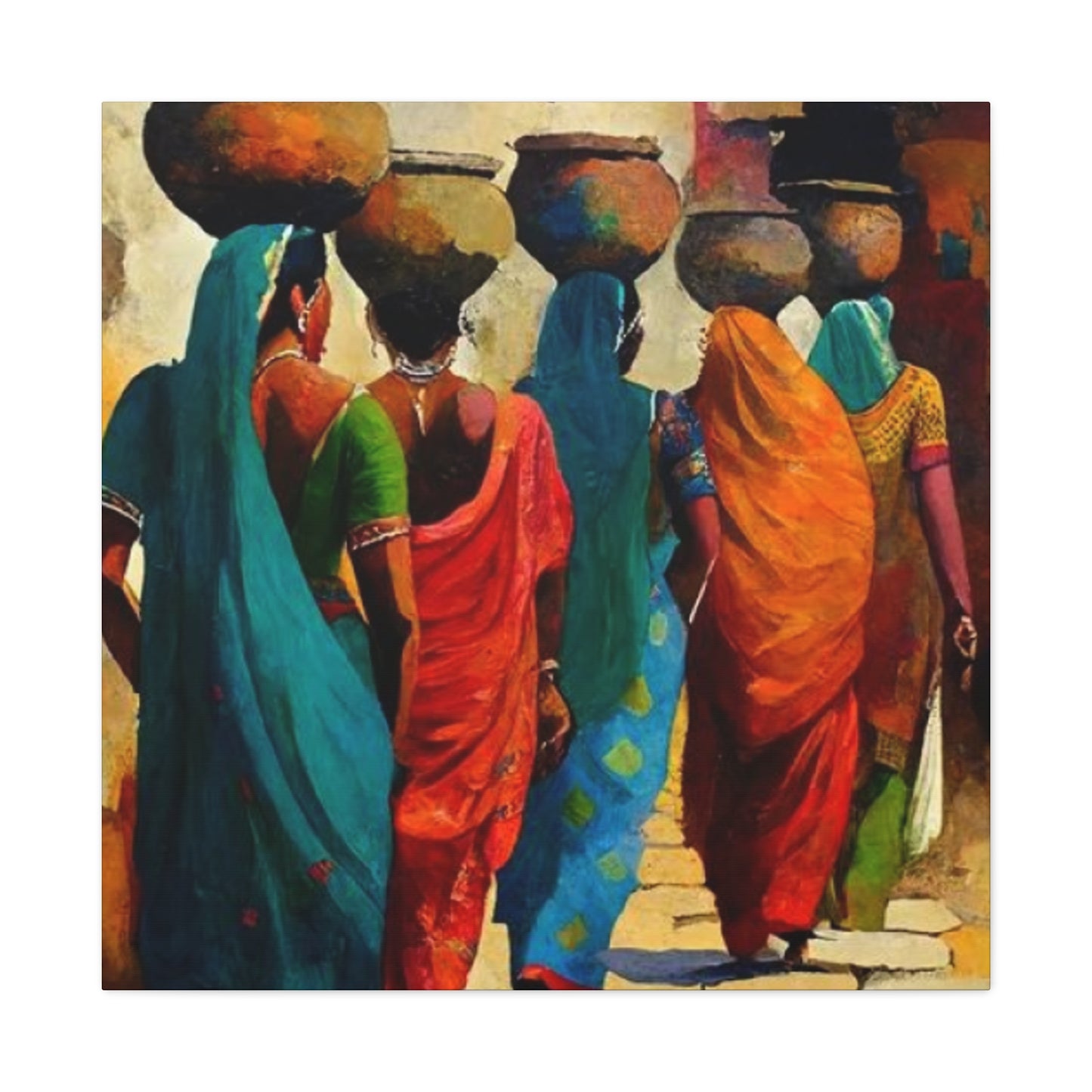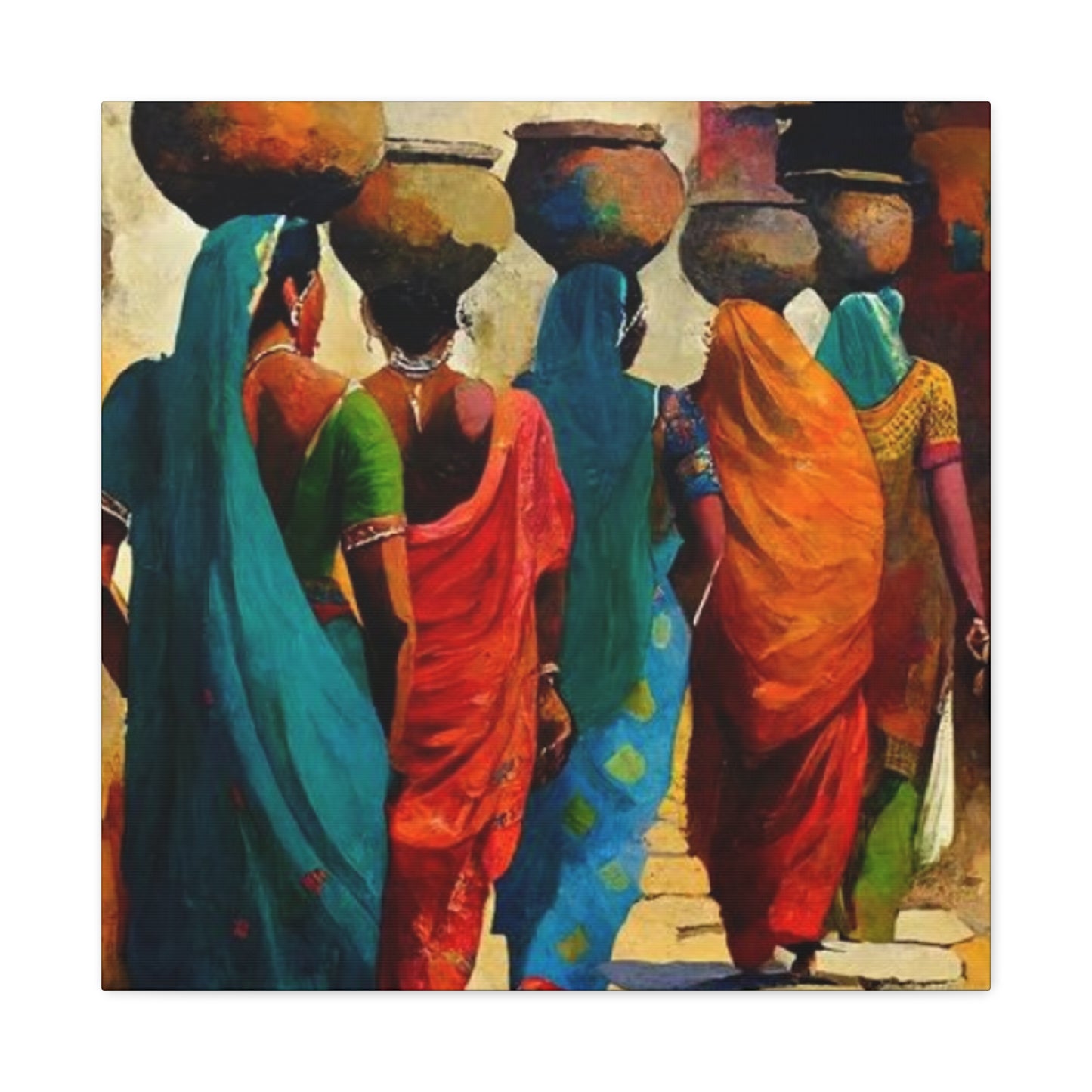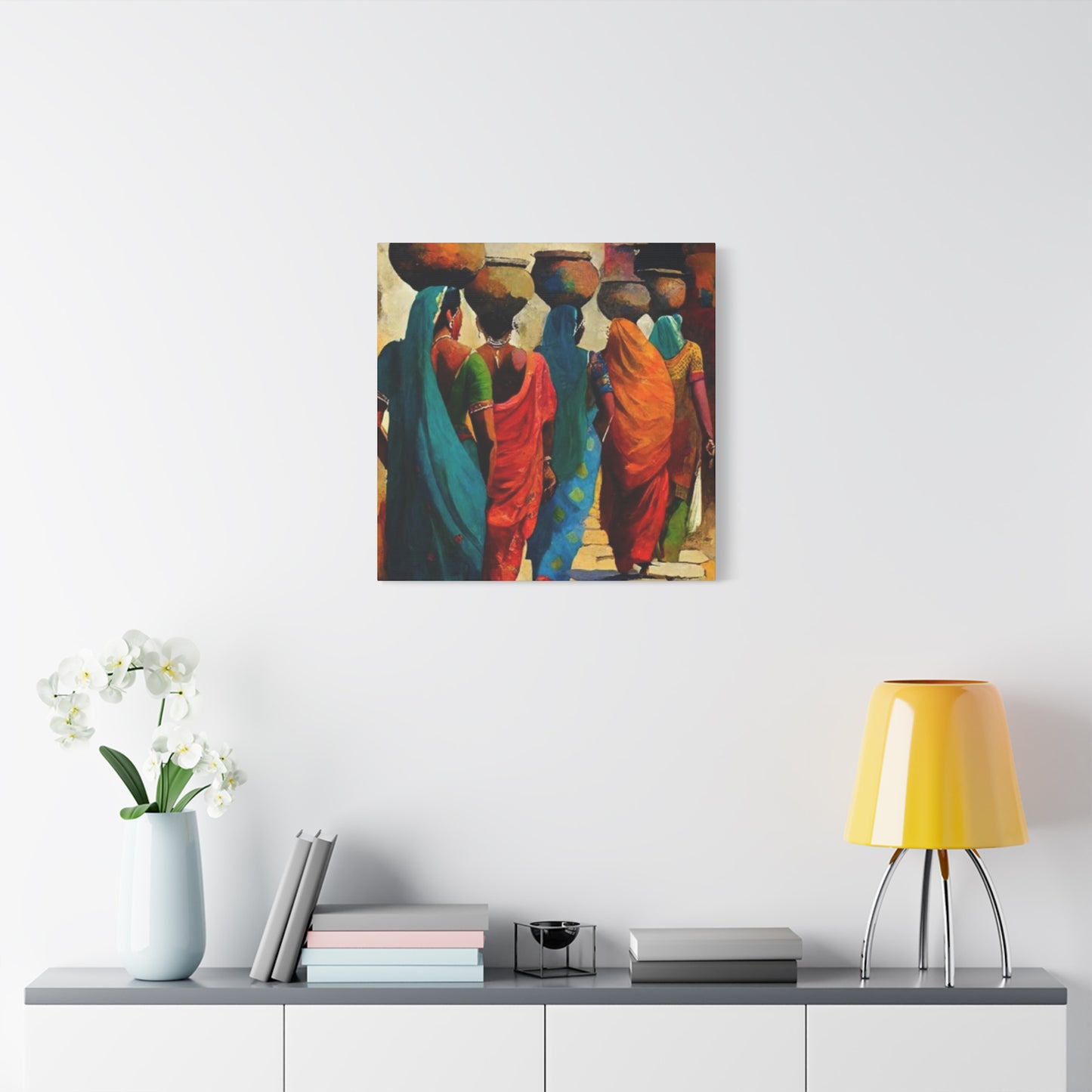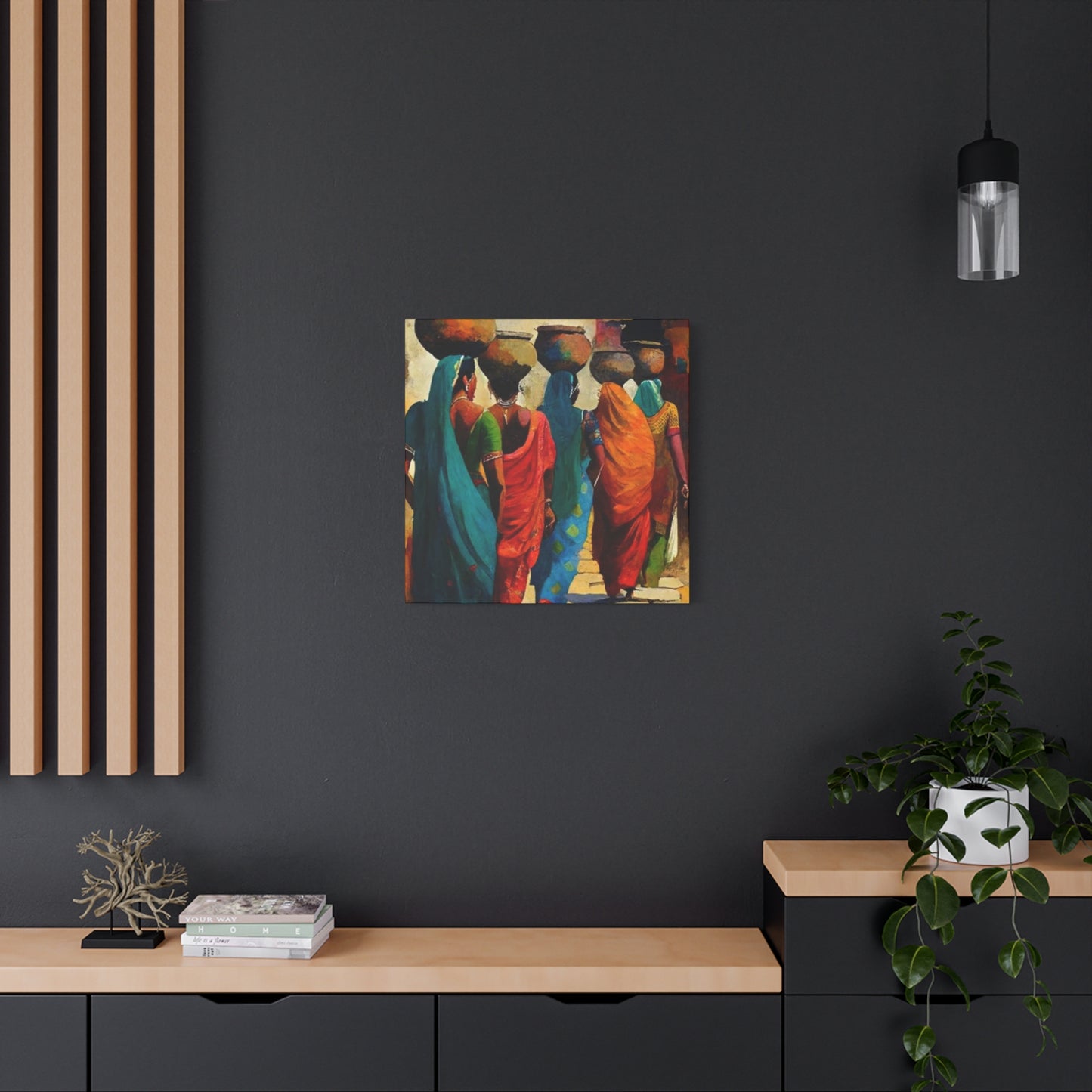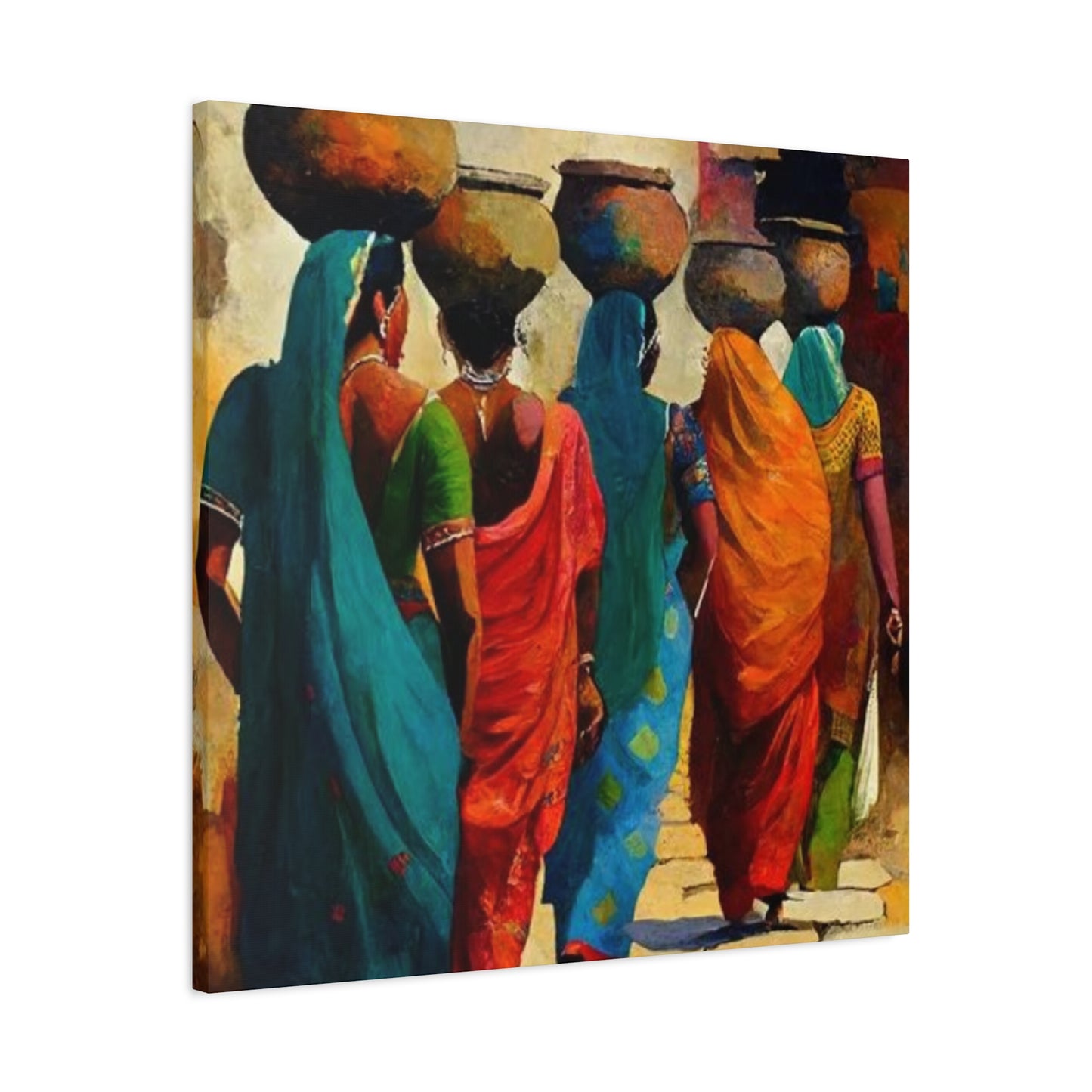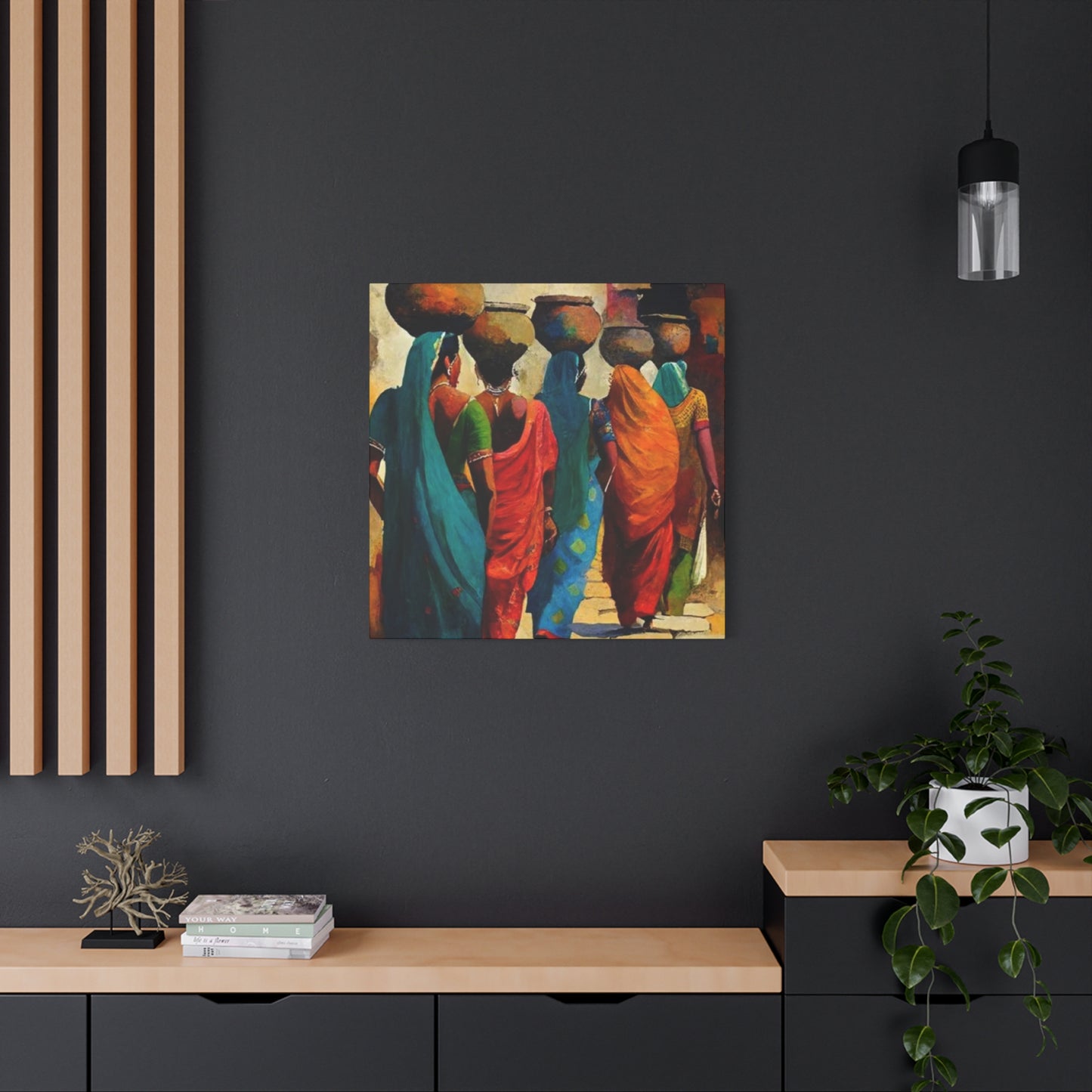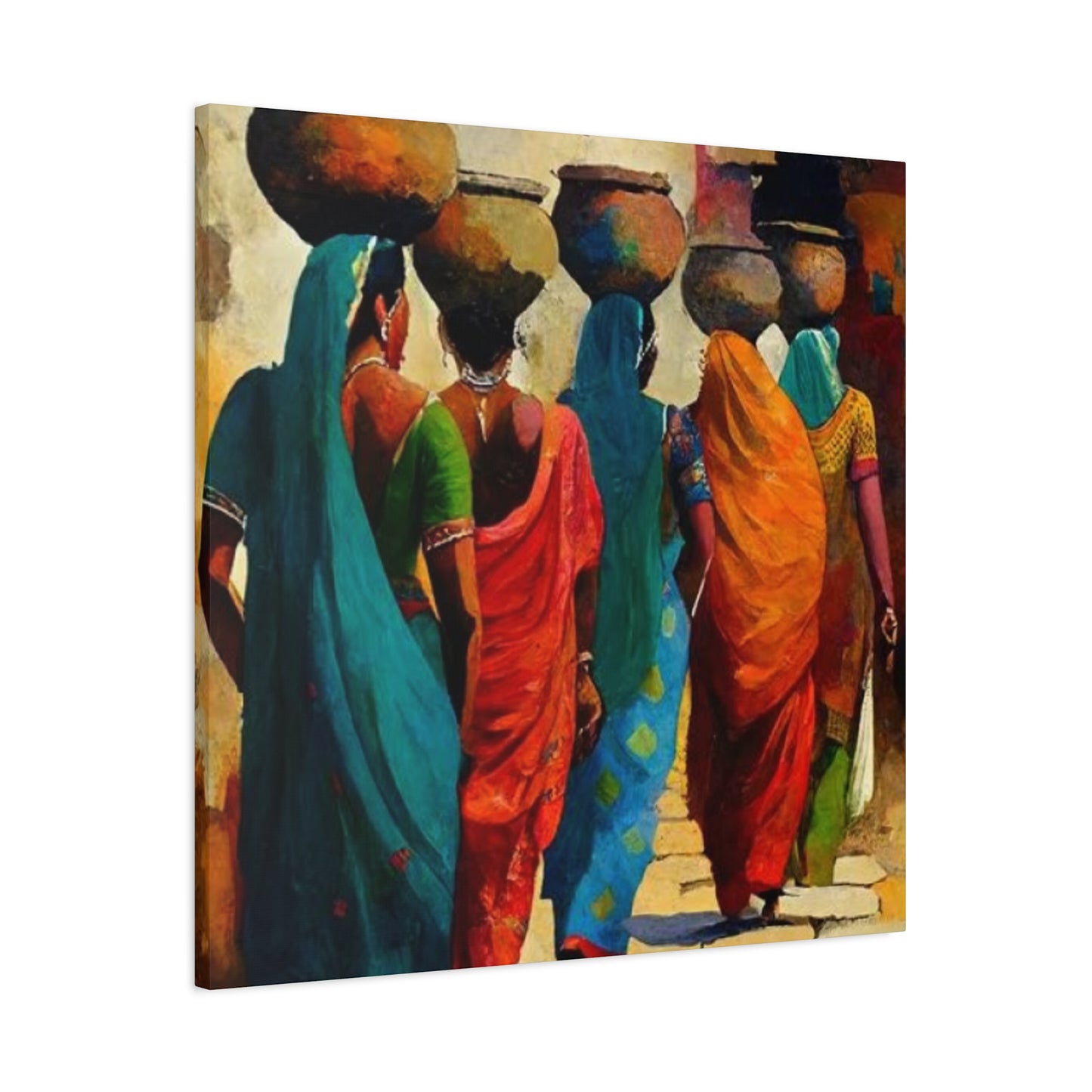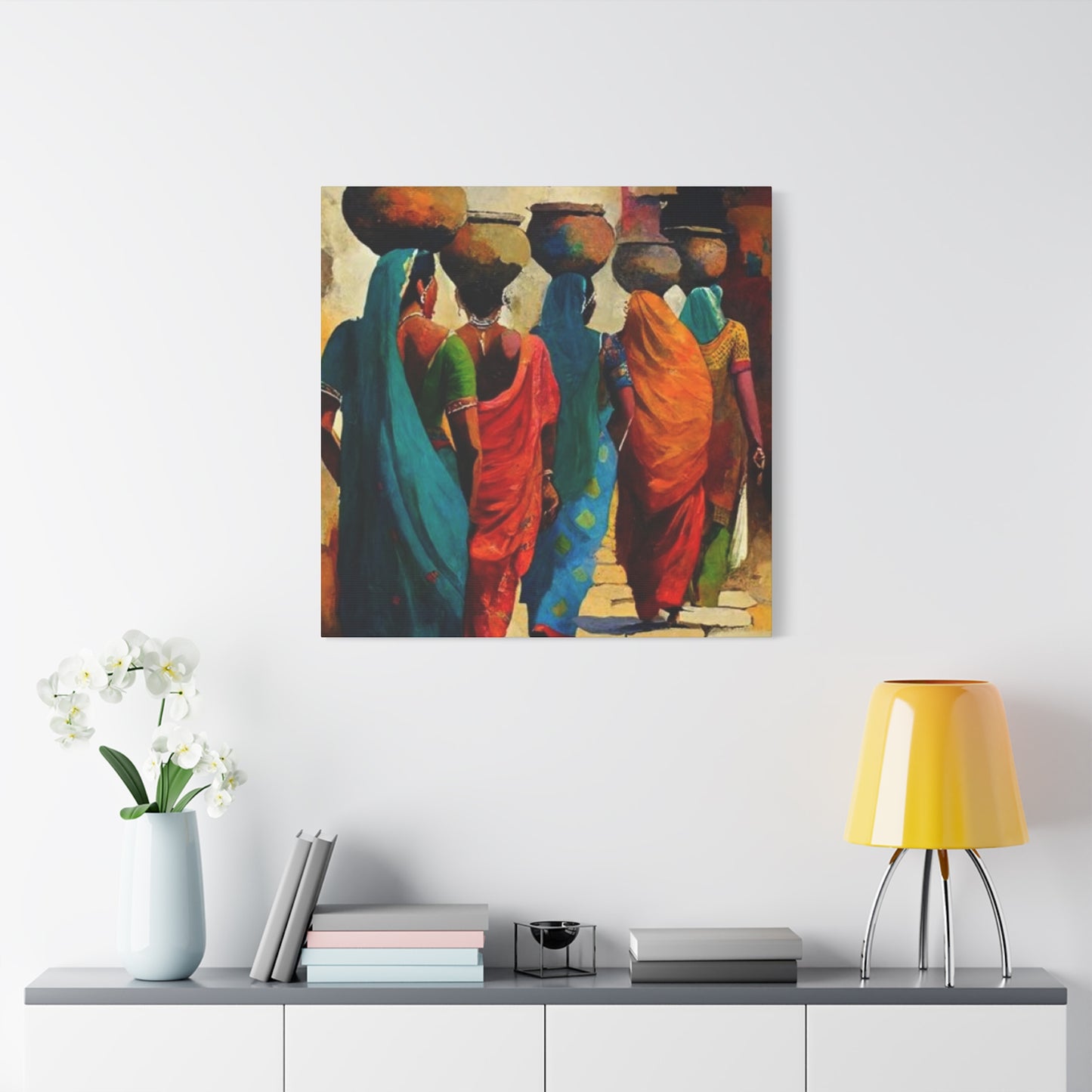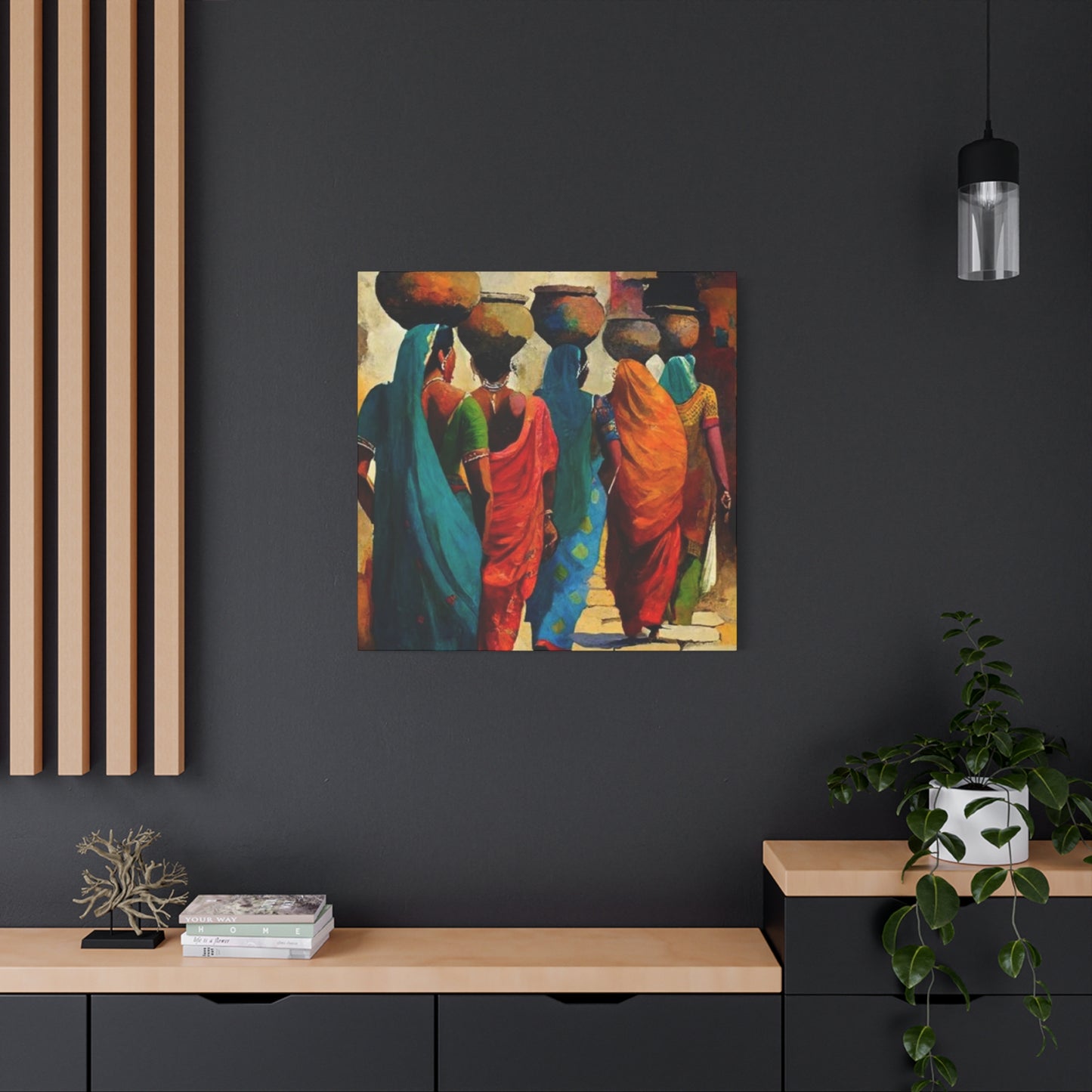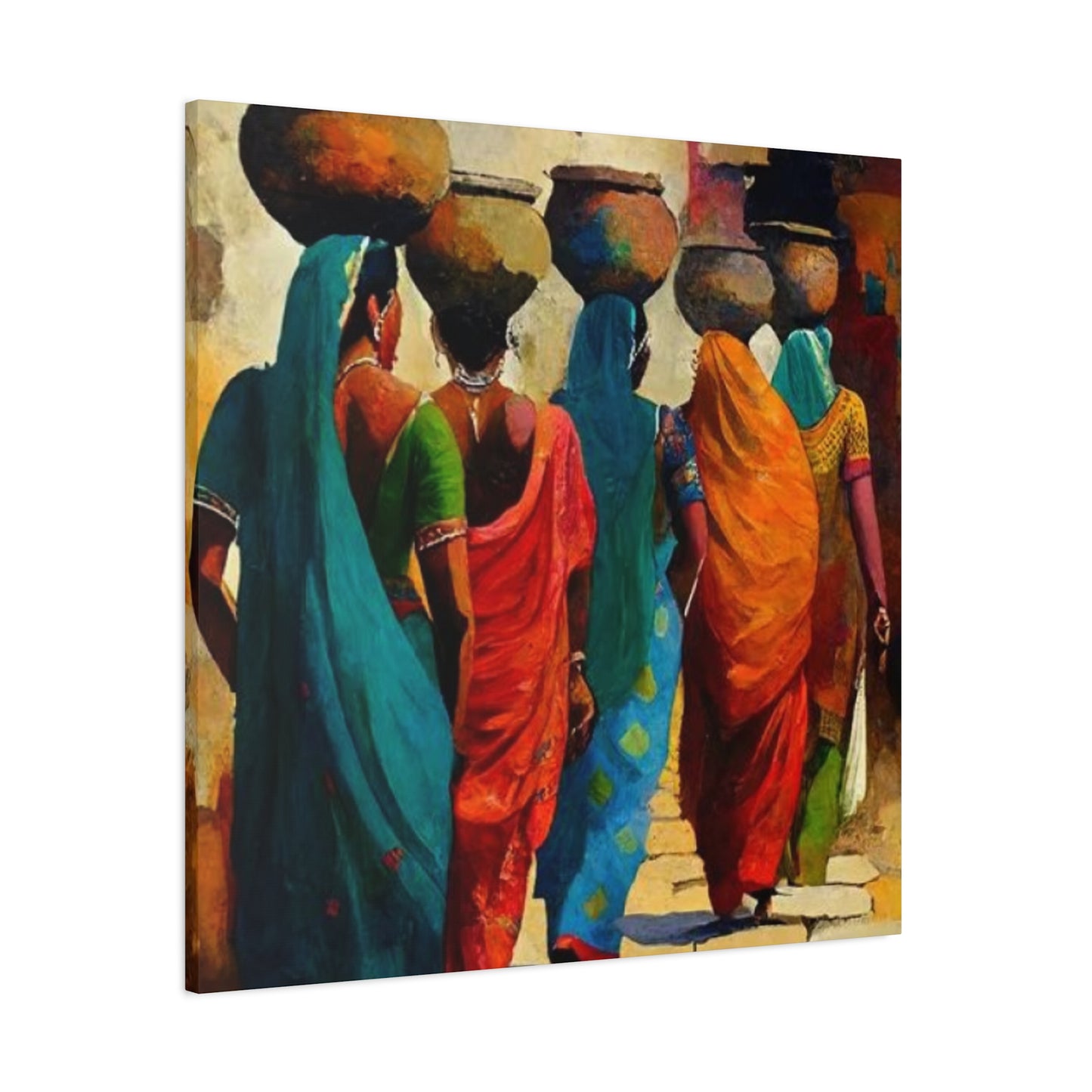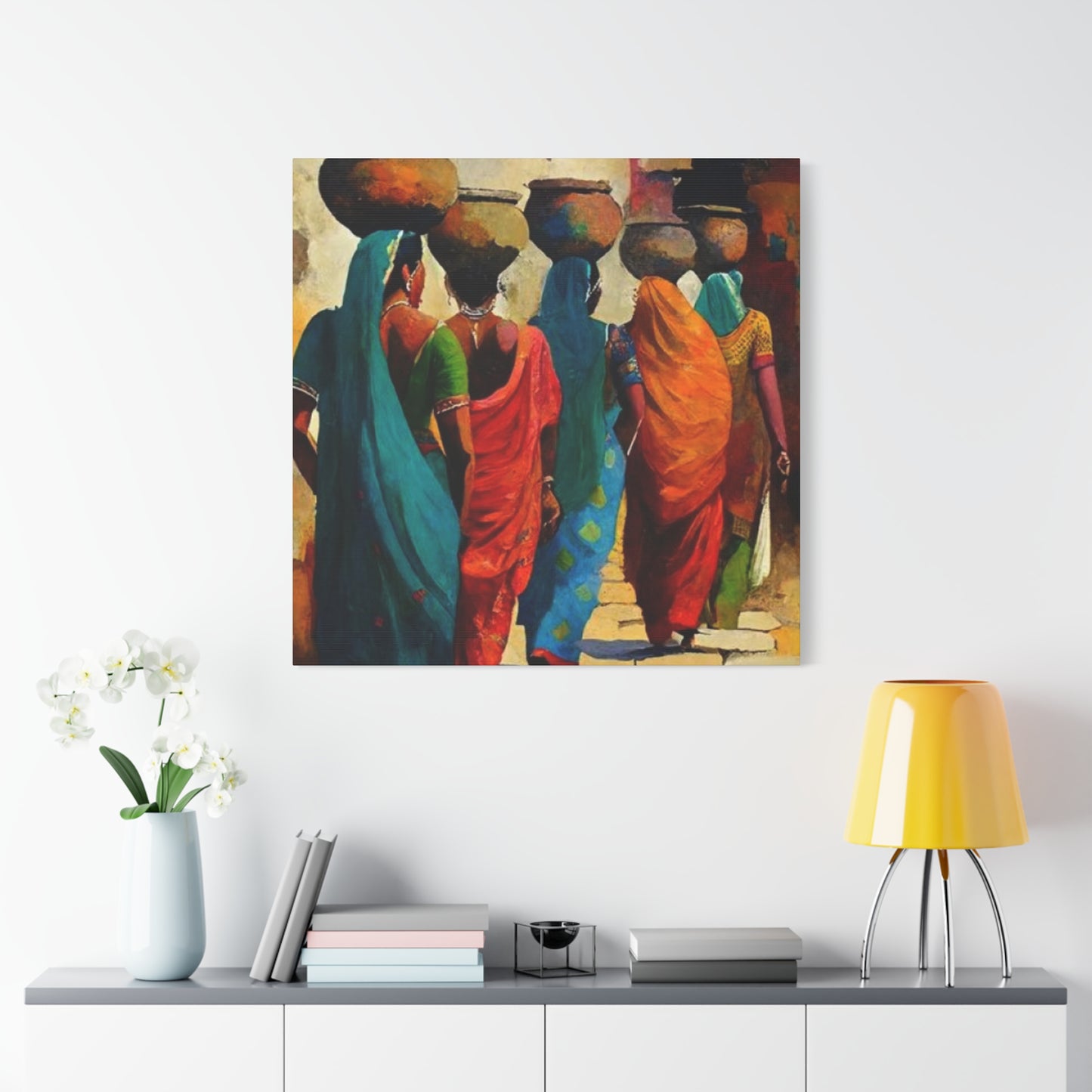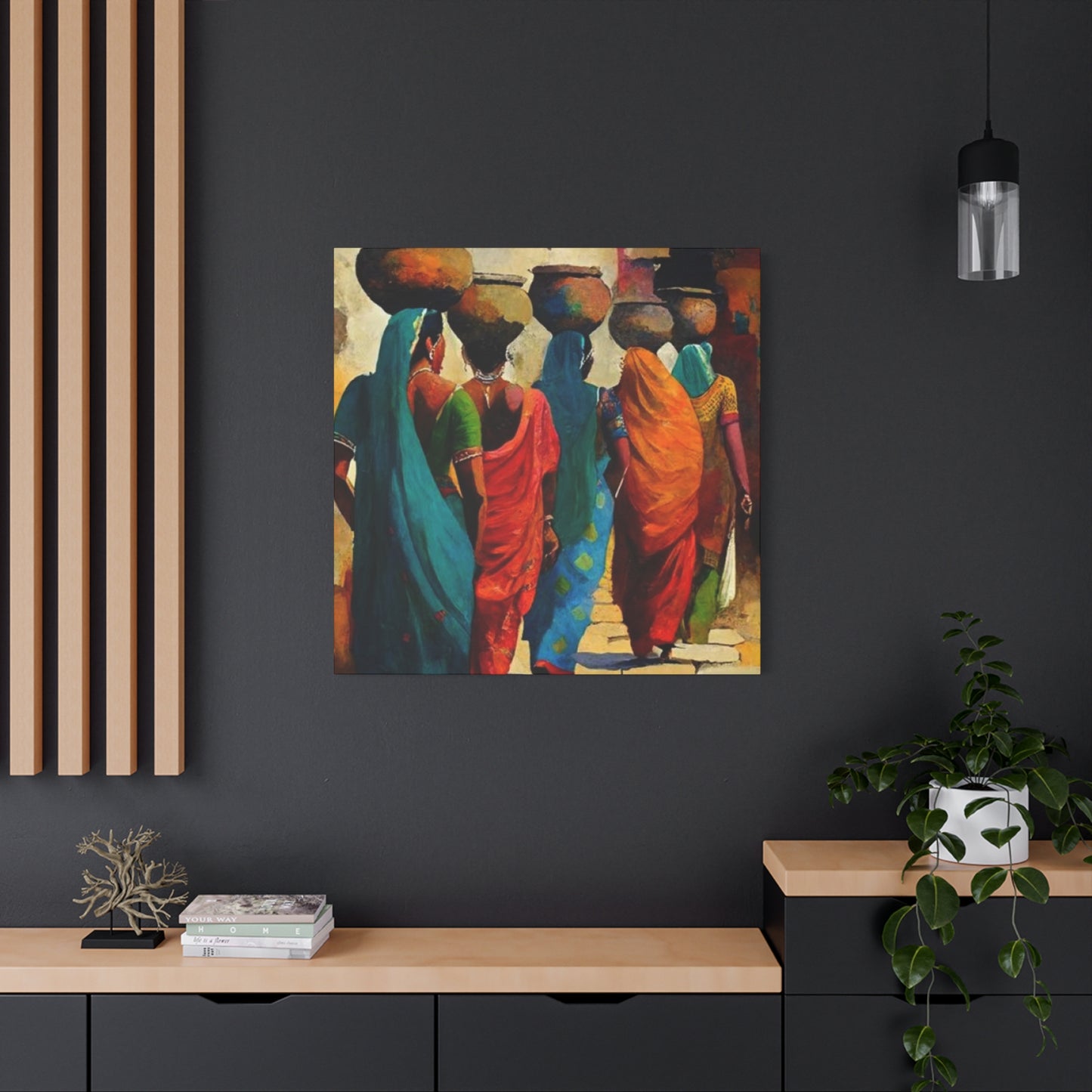Celebrating Heritage: The Beauty of Indian Cultural Women Wall Art
Indian cultural women wall art canvas prints represent a magnificent fusion of traditional heritage and contemporary artistic expression. These stunning visual pieces capture the timeless beauty, grace, and strength of Indian women throughout history. The artwork showcases diverse regional styles, from the vibrant colors of Rajasthan to the delicate patterns of Kerala, each piece telling a unique story of cultural identity and feminine power.
The artistic representation of Indian women in canvas prints has evolved significantly over centuries. Ancient cave paintings and temple murals laid the foundation for depicting feminine beauty in Indian art. Today's canvas prints draw inspiration from these historical sources while incorporating modern printing techniques and materials. Artists skillfully blend classical motifs with contemporary aesthetics, creating pieces that resonate with both traditional values and modern sensibilities.
Canvas prints featuring Indian women often incorporate symbolic elements deeply rooted in cultural mythology. The lotus flower, representing purity and enlightenment, frequently appears alongside female figures. Peacock feathers symbolize beauty and grace, while traditional jewelry and clothing elements add layers of cultural significance. These symbolic representations transform simple portraits into narratives that speak to the soul of Indian heritage.
The color palette used in these artworks reflects the vibrancy of Indian culture itself. Rich reds symbolize fertility and prosperity, golden yellows represent knowledge and learning, while deep blues evoke divinity and cosmic consciousness. Artists carefully select these hues to create visual harmony that captures the essence of Indian femininity. The interplay of warm and cool tones creates depth and dimension, bringing the canvas to life.
Traditional Indian Art Forms Depicted on Canvas
Madhubani painting style translates beautifully onto canvas prints, showcasing women in elaborate folk art traditions from Bihar. These geometric patterns and nature-inspired designs feature women engaged in daily activities, festivals, and mythological scenes. The distinctive double-line border and vibrant natural dyes create an authentic representation of this ancient art form. Contemporary artists have adapted these traditional techniques for modern canvas printing, preserving the cultural authenticity while making it accessible to global audiences.
Warli art presents a minimalist yet profound depiction of tribal life, with women playing central roles in community narratives. Originating from Maharashtra, this art form uses simple geometric shapes to create complex scenes of village life, harvest celebrations, and religious ceremonies. Women are portrayed as pillars of strength, managing households and participating in community rituals. The monochromatic schemes with occasional pops of color make these canvas prints versatile for various interior design schemes.
Pattachitra artwork from Odisha showcases intricate details and mythological storytelling through women characters. These scroll paintings, now available as canvas prints, feature bold lines, vibrant colors, and elaborate patterns. Female deities like Lakshmi and Durga are depicted with precision and devotion, their stories unfolding across the canvas surface. The traditional gum and natural color techniques have been adapted for modern printing, maintaining the artistic integrity while ensuring longevity.
Tanjore painting style, known for its gold foil embellishments and precious stone decorations, creates luxurious canvas prints of Indian women. These South Indian artworks traditionally depicted Hindu gods and goddesses, with female forms representing divine energy and power. Modern interpretations feature royal women, classical dancers, and mythological characters adorned with elaborate jewelry and rich fabrics. The characteristic raised relief work and gold accents add a three-dimensional quality to canvas prints.
Regional Variations in Women Portraiture
Rajasthani artwork celebrates the regal beauty of desert queens and village women adorned in mirror-work clothing and heavy silver jewelry. The artistic style emphasizes bold colors, particularly saffron, crimson, and emerald green, reflecting the vibrant culture of the region. Women are depicted performing traditional dances, fetching water from wells, or participating in festive celebrations. The characteristic large eyes and graceful poses convey both strength and elegance.
Bengali art traditions present women in softer, more romantic portrayals, often featuring classical dancers or literary figures from Rabindranath Tagore's works. The artistic style emphasizes flowing lines, subtle color transitions, and emotional depth. Saree-clad women engaged in cultural activities like music, poetry, and dance dominate these canvas prints. The influence of the Bengal School of Art is evident in the delicate brushwork and spiritual undertones.
South Indian canvas prints frequently showcase temple dancers in classical Bharatanatyam poses, their hand gestures telling ancient stories. The artistic precision in depicting mudras and facial expressions requires deep understanding of classical dance forms. Women are portrayed in traditional silk sarees with temple jewelry, their postures reflecting years of rigorous training. These prints capture not just physical beauty but also the spiritual discipline embodied in classical arts.
Kashmiri art brings forth the ethereal beauty of women against backdrop of snow-capped mountains and blooming saffron fields. The artistic style incorporates Persian influences with traditional Indian elements, creating unique visual narratives. Women in pherans, traditional Kashmiri robes, are shown harvesting saffron or weaving the famous Pashmina shawls. The cool color palette reflects the region's landscape while maintaining cultural authenticity.
Contemporary Interpretations of Traditional Themes
Modern artists reimagine classical Indian women portraits through abstract expressionism, deconstructing traditional forms while preserving cultural essence. These contemporary canvas prints use bold brushstrokes, unexpected color combinations, and unconventional compositions to challenge traditional representations. The fusion creates dialogue between past and present, questioning stereotypes while celebrating cultural identity. Young artists experiment with mixed media techniques, incorporating digital elements with hand-painted details.
Minimalist approaches to Indian women art focus on essential elements, using limited color palettes and simplified forms. These canvas prints strip away ornamental excess to reveal fundamental grace and strength. Single-line drawings of women in traditional poses or profiles capture elegance through simplicity. The negative space becomes as important as the figure itself, creating meditative pieces that invite contemplation.
Pop art influences merge with Indian cultural motifs, creating vibrant, energetic canvas prints that appeal to younger generations. These pieces feature women in traditional attire juxtaposed against modern urban backgrounds or contemporary patterns. The bold colors and graphic quality make strong visual statements, perfect for modern living spaces. Artists play with scale and repetition, techniques borrowed from Western pop art but infused with distinctly Indian elements.
Photorealistic canvas prints capture Indian women in stunning detail, preserving every texture of fabric, jewelry, and skin tone. These hyper-detailed artworks require exceptional technical skill and patience. The focus on authenticity creates intimate portraits that feel almost tangible. Photographers and digital artists collaborate to produce prints that honor traditional beauty standards while showcasing individual personality and character.
Mythological and Spiritual Representations
Goddess Durga representations show fierce feminine power astride a lion, her multiple arms wielding weapons against evil. These canvas prints capture the dynamic energy of the warrior goddess, her flowing hair and determined expression inspiring strength. Artists interpret this mythology through various styles, from traditional iconography to contemporary reimaginings. The symbolism of Durga as protector and destroyer resonates deeply in Indian consciousness.
Lakshmi depictions emphasize abundance, prosperity, and beauty, showing the goddess seated on a lotus with gold coins flowing. Canvas prints of Lakshmi often incorporate actual gold leaf or metallic inks to enhance the sense of wealth and fortune. The serene expression and blessing gestures make these prints popular for homes and businesses. Artists balance divine majesty with approachable grace, making the goddess feel both powerful and nurturing.
Saraswati artwork celebrates knowledge, music, and arts through elegant portrayals of the goddess with her veena instrument. These canvas prints often feature white and yellow tones, symbolizing purity and wisdom. The swan and lotus accompaniments add layers of spiritual meaning. Educational institutions and artists particularly favor these representations, seeing Saraswati as patron of learning and creativity.
Radha-Krishna narratives explore divine love through tender moments between the lovers in pastoral settings. These canvas prints capture the romantic and spiritual dimensions of their relationship. The blue-skinned Krishna and fair Radha create striking visual contrast while their intertwined poses suggest unity of souls. Artists draw from centuries of devotional poetry and painting traditions to create these timeless romantic portraits.
The Symbolism of Jewelry and Adornments
Traditional Indian jewelry depicted in canvas prints carries profound cultural and spiritual significance beyond mere decoration. The maang tikka at the forehead represents the third eye of wisdom and intuition. Nose rings symbolize married status in many communities while also enhancing facial beauty. Elaborate necklaces protect the throat chakra and display family wealth and status. Each piece of jewelry tells a story of social position, marital status, and regional identity.
The layering of multiple jewelry pieces creates visual richness in canvas artwork, with each adornment adding dimension and cultural context. Artists carefully render the intricate metalwork of temple jewelry, the delicate chains of Kundan necklaces, or the bold geometric patterns of tribal silver. The play of light on metallic surfaces adds dynamism to static images. Contemporary prints sometimes focus exclusively on jewelry, abstracting the female form to pure adornment.
Bridal jewelry representations showcase the most elaborate and precious adornments, marking major life transitions. Canvas prints featuring brides adorned head to toe in gold, diamonds, and precious stones celebrate this significant moment. The weight and value of bridal jewelry symbolize blessings for prosperity and protection in married life. Regional variations in bridal adornment provide endless artistic inspiration, from South Indian temple gold to Rajasthani meenakari work.
Flower adornments woven into braided hair represent natural beauty and cultural tradition in canvas portrayals. Jasmine strings in South India, marigold garlands in North India, and rose arrangements across regions each carry specific meanings. The temporary nature of flower jewelry contrasts with permanent metal ornaments, symbolizing the transient beauty of youth. Artists capture the delicate textures and fragrant associations through careful color work and composition.
Textile Patterns and Traditional Clothing
The saree, representing Indian femininity par excellence, drapes female forms in canvas prints with infinite variations of style and fabric. Artists dedicate careful attention to rendering silk sheens, cotton textures, and elaborate border work. The six-yard garment creates sculptural folds and elegant lines that define the female silhouette. Regional draping styles from Nivi to Bengali to Gujarati offer diverse aesthetic possibilities. The pallu, or decorative end piece, often features intricate designs that become focal points in artwork.
Lehenga choli ensembles popular in North India provide opportunities for depicting vibrant colors and mirror work embellishments. Canvas prints showcase women twirling in voluminous skirts, the fabric catching light and movement. The cropped blouse and flowing skirt combination emphasizes feminine curves while allowing freedom of movement. Festival and wedding scenes frequently feature women in these traditional outfits, creating dynamic, colorful compositions.
Salwar kameez representations display the grace of this versatile garment worn across India with regional variations. The flowing pants and tunic combination allows for comfortable movement while maintaining modesty. Artists render the delicate embroidery work of Punjabi phulkari or Lucknowi chikankari with meticulous detail. The dupatta, or scarf component, adds another layer of visual interest with its draping possibilities and decorative edges.
Traditional tribal clothing from various Indian communities brings unique aesthetic elements to canvas prints. The bold patterns, primary colors, and handwoven textures of tribal garments contrast with mainstream Indian fashion. Women from Nagaland, Madhya Pradesh, Gujarat, and other regions wear distinctive costumes that reflect their cultural identity. These representations preserve dying textile traditions and celebrate diversity within Indian culture.
Classical Dance Forms Captured on Canvas
Bharatanatyam dancers frozen in aramandi stance with precise hand mudras create powerful visual compositions on canvas. The angular body positions and expressive facial features require artistic skill to capture accurately. The traditional costume with pleated fan adds geometric interest while the temple jewelry provides ornamental detail. Artists must understand the dance form intimately to portray authentic poses and expressions. The spiritual dimension of this devotional dance style permeates the artwork.
Kathak pirouettes show women in flowing ghagras, their spinning forms creating circular patterns of color and movement. Canvas prints capture the moment of perfect balance, the dancer's gaze fixed on a point as she whirls. The intricate footwork suggested through pose and composition conveys the rhythmic complexity of this North Indian classical form. The fusion of Hindu and Muslim cultural elements in Kathak costume and style offers rich artistic possibilities.
Odissi tribhanga poses, with their characteristic three-bend body position, create sensuous curves that artists love to portray. This ancient dance form from Odisha features women in silver jewelry and silk sarees, their poses mirroring temple sculptures. The soft, lyrical quality of Odissi movements translates into flowing lines and graceful compositions. Artists often include elements of temple architecture in backgrounds, emphasizing the dance form's devotional origins.
Mohiniyattam, Kerala's classical dance performed exclusively by women, brings subtle grace to canvas representations. The swaying movements, gentle expressions, and white-and-gold costume create serene, meditative artworks. The lasya, or feminine aspect of dance, dominates Mohiniyattam imagery. Artists capture the dancer's eyes, which tell stories through subtle movements, and the delicate hand gestures that define this dance form.
Rural Life and Daily Activities
Village women carrying water pots on their heads represent timeless scenes of rural Indian life on canvas. The balanced posture required for this daily task creates elegant vertical lines in artwork. The earthen vessels themselves become sculptural elements, their rounded forms contrasting with the angular postures. These scenes celebrate the strength and grace of ordinary women performing essential tasks. The rural landscape backdrop situates the activity within specific geographic and cultural contexts.
Harvest scenes show women working in fields, their colorful clothing bright against green or golden crops. These canvas prints document agricultural labor often overlooked in urban-centric art. Women harvesting rice, picking tea leaves, or cutting wheat embody the connection between femininity and earth's fertility. The communal nature of farm work creates opportunities for depicting multiple figures in harmonious compositions. Traditional songs and rhythms associated with field work add invisible dimensions to these visual narratives.
Marketplace scenarios feature women vendors selling vegetables, flowers, or handcrafted goods, their faces showing life experience and wisdom. These portraits capture economic independence and community roles beyond domestic spheres. The colorful array of merchandise creates vibrant still-life elements surrounding the central female figure. Artists document specific regional market cultures, from floating vegetable markets in Kashmir to flower bazaars in Tamil Nadu.
Cooking scenes depict women preparing traditional meals over chulhas, their hands skilled in ancient culinary arts. The domestic space becomes honored rather than diminished in these representations. Steam rising from vessels, spices arranged in bowls, and the focused concentration of the cook create intimate, warm compositions. These canvas prints celebrate the nurturing aspect of femininity and the cultural transmission that occurs through food preparation.
Wedding Ceremonies and Celebrations
Bridal portraits capture the transformation of women through elaborate makeup, jewelry, and ceremonial clothing on their wedding day. Canvas prints preserve these precious moments when women embody cultural ideals of beauty and transition into new life phases. The mixture of joy, nervousness, and solemnity in bridal expressions creates emotionally complex artwork. Regional variations in wedding attire provide endless diversity, from red lehengas to white silk sarees to gold-adorned ensembles.
Mehendi ceremony depictions show women's hands and feet elaborately decorated with henna in intricate patterns. These pre-wedding rituals celebrate feminine beauty and fertility through temporary body art. Canvas prints often feature close-up views of henna designs, turning decorative patterns into abstract art. The communal aspect of mehendi application, with female relatives and friends gathering, creates opportunities for group compositions showing multiple generations.
Wedding procession scenes show brides departing parental homes or arriving at in-laws' residences, marking significant life transitions. These emotionally charged moments inspire powerful artwork that captures both celebration and melancholy. The architectural elements of traditional homes and the presence of family members add narrative depth. Artists balance the personal and communal dimensions of these ceremonies, showing individual experience within cultural frameworks.
Festival celebration artwork depicts women in their finest clothing participating in Diwali, Holi, Navratri, and other celebrations. The explosive colors of Holi, the lights of Diwali, and the dance of Navratri create dynamic, energetic compositions. Women's central roles in organizing and participating in festivals make them natural subjects for these cultural celebrations. The joy and spiritual devotion evident in festival scenes create uplifting, positive artwork.
Mother and Child Representations
Maternal imagery showing mothers nursing or cradling infants evokes universal themes of nurturing and love. These canvas prints capture the tender intimacy between mother and child, a bond transcending cultural specifics. The protective curve of a mother's body around her baby creates naturally pleasing compositions. Indian maternal iconography draws from goddess imagery, particularly depictions of Yashoda with infant Krishna, blending human and divine motherhood.
Multi-generational family scenes show grandmothers, mothers, and daughters together, illustrating the transmission of cultural knowledge and values. These compositions demonstrate the respected position of elder women in Indian society. The visual contrast between aged and youthful faces, yet the similarity in features, creates poignant artwork about time, continuity, and identity. Traditional activities like cooking, storytelling, or ritual preparation provide natural settings for these intergenerational portraits.
Mother teaching daughter traditional skills like embroidery, cooking, or dance creates narrative artwork about cultural preservation. These scenes document informal education that occurs within domestic spaces, often overlooked yet culturally vital. The concentration and care evident in both teacher and student faces reveal the importance of this knowledge transfer. Canvas prints of these moments honor women's roles as culture bearers and wisdom keepers.
Pregnant women depicted with beauty and reverence celebrate fertility and the creative power of the feminine. Unlike Western art traditions that often hide pregnancy, Indian cultural artwork embraces this powerful state. The rounded belly becomes a sacred symbol of potential life and divine blessing. Artists use composition, lighting, and symbolic elements to convey the spiritual dimension of pregnancy beyond its physical reality.
Royal and Historical Women Figures
Rani Lakshmibai, the warrior queen of Jhansi, appears in canvas prints as symbol of courage and resistance. These dramatic artworks show her in battle gear, sword raised, riding into combat against colonial forces. The historical importance of her rebellion makes her an inspirational figure, particularly for women. Artists balance historical accuracy with heroic idealization, creating images that serve both documentary and motivational purposes.
Empress Nur Jahan, powerful Mughal queen, is portrayed in luxurious court settings wearing elaborate jewelry and fine fabrics. These artworks emphasize her political acumen and cultural patronage alongside her legendary beauty. The Persian-influenced artistic style appropriate to Mughal period adds exotic appeal to these historical portraits. Contemporary feminist readings of Nur Jahan's life inform modern artistic interpretations.
Razia Sultana, Delhi's only female sultan, provides another powerful historical subject for canvas artwork. Her story of breaking gender barriers in medieval India resonates with modern audiences. Artists depict her in both feminine court dress and masculine battle attire, illustrating her navigation of gender expectations. The tragic dimension of her story adds emotional depth to these historical representations.
Regional queens and princesses from various Indian kingdoms offer diverse subjects for royal portraiture. From Padmini of Mewar to Ahilyabai Holkar of Indore, these women wielded power and influenced history. Canvas prints preserve their memories and serve as inspiration for contemporary women. The fine clothing, architectural settings, and courtly atmospheres create visually rich, sophisticated artwork.
Seasonal and Nature-Inspired Themes
Monsoon scenes depict women welcoming rains after long hot summers, their wet clothes clinging to bodies, faces upturned joyfully. The cultural and emotional significance of monsoon in Indian consciousness makes these powerful subjects. The contrast between dry earth and sudden greenery, between waiting and fulfillment, creates dramatic visual metaphors. Artists capture the sensual freedom and relief associated with monsoon's arrival.
Spring festival imagery shows women surrounded by flowering trees and colorful blooms celebrating seasonal renewal. The connection between feminine fertility and earth's renewal appears in these compositions. Blossom petals falling like blessings add movement and grace to static images. The fresh colors of spring translate into vibrant, optimistic canvas prints that celebrate life's cyclical nature.
Summer harvest scenes feature women gathering mangoes, their bodies shaded by heavy-laden trees in blazing sunshine. The golden light of Indian summer creates warm tones and strong contrasts in these artworks. The abundance of fruit symbolizes prosperity and nature's generosity. Despite the harsh heat suggested by bright light, the compositions convey satisfaction and plenty.
Winter morning moments show women wrapped in shawls against misty backdrops, their breath visible in cool air. These quieter, more contemplative scenes contrast with the drama of monsoons or the abundance of harvest times. The subdued color palette and soft focus create meditative, peaceful artwork. The suggestion of warmth despite cold emphasizes resilience and inner strength.
Abstract and Symbolic Representations
Chakra symbolism integrated into female forms creates spiritually charged abstract canvas prints. The seven energy centers visualized as glowing circles along the body's vertical axis add esoteric meaning to portraits. Artists use specific colors associated with each chakra, creating rainbow-like vertical compositions. These pieces appeal to yoga practitioners and those interested in Hindu spiritual philosophy.
Mandala designs incorporating feminine forms dissolve individual identity into cosmic patterns. The circular, symmetrical structures suggest completeness and universal consciousness. Women's bodies become parts of larger sacred geometries, their curves integrated into mandala architecture. These abstract works transcend individual portraiture to suggest archetypal feminine energy.
Third eye emphasis in portraits highlights the spiritual dimension of feminine consciousness. The area between eyebrows receives special artistic attention, sometimes depicted as literally opened or marked with symbolic designs. This focus on inner vision rather than outer appearance creates powerful spiritual artwork. The gaze becomes less about seeing and more about knowing.
Lotus positioning shows women seated in padmasana, their meditation pose creating stable triangular compositions. The association between lotus flower and spiritual enlightenment adds symbolic depth. These serene images convey inner peace and spiritual discipline. The simplification of form that often accompanies these spiritual subjects creates clean, powerful visual statements.
Framing and Display Considerations
Floating frame styles create modern, gallery-like presentations for Indian women canvas prints. The gap between canvas edge and frame creates shadow lines that add depth perception. This mounting method emphasizes the canvas as object rather than picture, adding contemporary sophistication. The frame color choice affects overall aesthetic, with natural wood warm tones or black modern minimalism.
Gallery wrap techniques stretch canvas around wooden frames so the image continues around sides. This frameless approach allows for versatile display options and emphasizes the artwork itself. The wrapped edges require careful planning so important elements don't disappear around corners. This method suits contemporary interiors where clean lines and uninterrupted surfaces dominate.
Traditional ornate frames in gold or carved wood complement classical Indian artwork styles. These elaborate frames become part of the artwork itself, adding cultural authenticity. The decorative frames particularly suit Tanjore-style prints or Mughal-inspired portraits. The frame weight and visual presence should balance with the artwork's complexity and color intensity.
Multi-panel arrangements allow large-scale compositions to span several canvases, creating dramatic wall installations. These triptychs or larger sets can show sequential narratives or single images divided for visual impact. The spacing between panels affects how the eye connects separate pieces into unified compositions. Multi-panel arrangements work particularly well for depicting dance movements or procession scenes.
Size Variations and Scale Considerations
Large statement pieces measuring several feet across dominate spaces and serve as room focal points. These oversized canvas prints require sufficient wall space and viewing distance to appreciate fully. The scale allows for impressive detail and emotional impact but demands careful placement. Living rooms, offices, or commercial spaces benefit from bold-sized Indian women artwork that commands attention.
Medium-sized prints offer versatility for various spaces without overwhelming smaller rooms. These dimensions work well for bedroom walls, dining areas, or office spaces. The moderate scale allows for appreciating details while maintaining manageable proportions. Multiple medium prints can create gallery walls showing thematic variations or complementary subjects.
Small canvas prints provide accent pieces or components of larger gallery wall arrangements. These intimate sizes suit personal spaces like dressing areas, reading nooks, or bathroom decor. The smaller scale allows for closer viewing and appreciation of fine details. Collections of small prints can be arranged creatively to fill irregular wall spaces.
Custom sizing accommodates specific space requirements and personal preferences. The ability to order exact dimensions ensures perfect fit for challenging wall spaces. Custom sizing allows for maintaining proper image proportions rather than forcing standard dimensions. This flexibility particularly benefits those matching existing furniture or architectural elements.
Cultural Education Through Visual Art
Canvas prints serve educational purposes by preserving and transmitting cultural knowledge to younger generations. Children growing up with Indian women artwork absorb cultural values and aesthetic traditions unconsciously. The visual presence of traditional clothing, jewelry, and customs maintains continuity with heritage. These educational aspects make canvas prints valuable beyond mere decoration.
Diaspora communities use Indian women canvas prints to maintain cultural connections while living abroad. The artwork serves as daily reminder of roots, traditions, and identity in foreign environments. Second and third generation immigrants particularly benefit from visual cultural education that complements family stories. The prints become conversation starters about heritage and history.
Cross-cultural appreciation develops when non-Indian audiences engage with these artistic representations. The artwork challenges stereotypes and reveals cultural complexity to outsiders. Educational institutions, cultural centers, and diversity-focused spaces use these prints to promote understanding. The visual accessibility of art makes it powerful tool for cultural bridge-building.
Art history documentation occurs as canvas prints preserve traditional art forms in accessible formats. Endangered folk art traditions reach wider audiences through modern reproduction technologies. The commercial viability of canvas prints creates economic incentives for preserving traditional artistic knowledge. Documentation through art helps prevent cultural loss and erasure.
The Role of Women Artists
Contemporary female artists bring authentic perspectives to representations of Indian women's experiences. Their insider understanding of feminine life in Indian contexts adds depth and nuance to artwork. Women artists often challenge objectifying traditions, creating portraits that emphasize agency and subjectivity. The growing prominence of female artists shifts whose stories get told and how.
Traditional female artists working in folk traditions like Madhubani or Warli continue heritage practices through canvas print production. These artists maintain techniques passed through maternal lineages while adapting to commercial markets. The income generated from canvas print sales supports rural women artists economically. Recognition of female folk artists challenges assumptions about who creates valuable art.
Feminist artistic interpretations question traditional gender roles while respecting cultural identity. These artists navigate tension between cultural preservation and progressive gender politics. Their work often features strong, independent women challenging patriarchal norms. The canvas print medium makes these feminist messages accessible beyond gallery audiences.
Cross-cultural collaboration between Indian and international women artists creates innovative fusion styles. These partnerships generate fresh perspectives on Indian femininity that avoid both orientalism and cultural essentialism. The collaborative process itself models possibility of respectful cultural exchange. Resulting artworks appeal to globally minded audiences seeking authentic yet contemporary cultural expression.
Spiritual and Meditative Applications
Yoga and meditation spaces utilize canvas prints of serene Indian women to enhance contemplative atmospheres. The calm expressions and spiritual symbols support mindfulness practices. The visual focus on a peaceful face can aid concentration during meditation. These functional applications demonstrate how artwork serves purposes beyond aesthetic appreciation.
Altar and prayer room decorations feature canvas prints of goddesses and spiritual women. These sacred spaces benefit from visual reminders of divine feminine energy. The prints receive flowers, incense, and other offerings as part of devotional practices. The commercial accessibility of quality spiritual artwork democratizes access to meaningful imagery.
Healing and wellness centers choose canvas prints depicting balanced, harmonious female figures. The therapeutic environments benefit from calming, positive imagery. Art therapy applications use these images to explore identity, culture, and feminine experience. The psychological impact of surrounding imagery influences emotional states and healing processes.
Chakra meditation practices employ canvas prints showing the energy centers aligned along female spines. These visual aids help practitioners locate and focus on specific chakras during meditation. The combination of feminine form and energy symbolism creates powerful tools for spiritual practice. The educational aspect helps newcomers understand abstract concepts through concrete images.
Commercial and Hospitality Applications
Hotels and resorts with Indian themes use canvas prints to establish authentic cultural atmosphere. The artwork communicates cultural identity to international guests while celebrating local heritage. Strategic placement in lobbies, hallways, and rooms creates immersive experiences. The durability of canvas suits high-traffic commercial environments.
Restaurants serving Indian cuisine enhance dining experiences with culturally appropriate artwork on walls. The visual elements complement culinary traditions, creating multisensory cultural experiences. Regional restaurants might feature women from specific areas, adding educational dimension to dining. The artwork becomes talking point, enriching customers' cultural understanding.
Retail boutiques selling Indian clothing, jewelry, or crafts use canvas prints to create branded environments. The artwork establishes aesthetic coherence and cultural authenticity. Customers shopping for cultural goods appreciate environments that honor those traditions visually. The aspirational quality of beautiful artwork influences purchasing decisions.
Wellness spas offering Ayurvedic or yoga-based services incorporate Indian women canvas prints into healing environments. The artwork supports the holistic, culturally specific wellness philosophies these businesses promote. The serene imagery contributes to stress reduction and relaxation. Cultural authenticity in visual elements enhances credibility and client trust.
Gifting and Special Occasions
Housewarming gifts featuring auspicious images of Lakshmi or prosperous village women bless new homes with good fortune. The cultural appropriateness of such gifts demonstrates understanding of traditions and values. Quality canvas prints represent substantial, thoughtful presents rather than token offerings. The lasting nature of artwork means the gift provides enduring pleasure.
Wedding gifts depicting happy couples or symbolic representations of marital harmony celebrate unions meaningfully. These gifts acknowledge cultural context while offering beautiful decoration for new households. The personal nature of selecting specific artwork shows care and consideration. Anniversary gifts might feature romantic scenes or goddess imagery relevant to the couple.
Mother's Day presents honoring maternal roles through canvas prints showing mothers and children resonate emotionally. The cultural specificity of Indian maternal imagery makes these gifts meaningful for South Asian mothers. The artwork celebrates motherhood in culturally authentic ways rather than generic sentiments. Personalization options allow for even more meaningful gifts.
Cultural celebration gifts for Diwali, Navratri, or other festivals featuring relevant imagery mark occasions specially. These gifts demonstrate cultural knowledge and respect for traditions. The seasonal appropriateness adds thoughtfulness beyond generic presents. Collections can be built over years, marking each festival with new additions.
Online Shopping and Selection Process
Virtual room visualization tools help buyers preview how canvas prints will look in actual spaces before purchasing. These augmented reality applications use smartphone cameras to place artwork digitally on walls. The technology reduces uncertainty about size, color compatibility, and overall aesthetic fit. This innovation particularly helps when buying large statement pieces requiring significant investment.
Customer review systems provide insights into print quality, color accuracy, and customer service experiences. Reading others' experiences helps avoid problematic sellers and identifies reliable sources. Photographic reviews showing actual received products prove particularly valuable. The collective wisdom of previous buyers guides new purchasers toward satisfactory choices.
Return policies and satisfaction guarantees protect buyers from disappointments with online art purchases. Understanding terms before purchasing prevents frustration if artwork doesn't meet expectations. Generous return windows allow adequate time for living with pieces before final commitment. These policies reduce risk in buying artwork sight unseen.
Sample swatch programs allow examination of canvas material and print quality before committing to full-sized purchases. Small samples demonstrate texture, color vibrancy, and finish options. The minimal cost of samples prevents expensive mistakes. Serious collectors often order multiple samples when considering significant purchases.
Customization and Personalization Options
Portrait customization services transform photographs into stylized Indian cultural artwork. Family photos rendered in Madhubani style or Tanjore painting aesthetics create unique personal pieces. The fusion of personal identity with cultural artistic traditions produces meaningful one-of-kind artworks. These customized pieces make especially thoughtful gifts celebrating both individual and cultural identity.
Color scheme adjustments allow matching canvas prints to specific interior design palettes. Requesting modifications to background colors or clothing hues ensures perfect coordination with existing decor. This customization maintains artistic integrity while accommodating practical decorating needs. The ability to adjust colors makes artwork versatile for various design schemes.
Size modifications accommodate specific wall dimensions or display requirements not met by standard options. Requesting custom dimensions ensures artwork fits perfectly without awkward gaps or overwhelming spaces. Maintaining proper aspect ratios during resizing preserves artistic composition and prevents distortion. Custom sizing justifies slightly higher prices through perfect integration with spaces.
Text additions like family names, meaningful quotes, or dates personalize canvas prints for special occasions. Traditional Sanskrit blessings or regional language phrases add cultural authenticity to personalized pieces. The textual elements integrate with imagery rather than appearing as afterthoughts. Typography choices affect whether additions enhance or detract from overall compositions.
Social Media and Digital Marketing
Instagram galleries showcase canvas print collections, inspiring potential buyers through styled photography. The visual platform naturally suits artwork promotion, allowing detailed views and lifestyle context shots. Hashtags connect Indian women canvas print enthusiasts into communities sharing appreciation and recommendations. Artists and sellers build followings that translate into sales and commissions.
Pinterest boards curate inspiration for decorating with Indian women canvas prints across style categories. The platform's organizational structure helps users visualize thematic groupings and style combinations. Linking pins directly to purchase pages streamlines path from inspiration to acquisition. The longevity of Pinterest content continues generating interest long after initial posting.
YouTube videos demonstrate unboxing experiences, hanging techniques, and styling suggestions for canvas prints. The video format allows showing scale, texture, and color accuracy better than photographs alone. Influencer reviews and recommendations carry weight with audiences seeking trustworthy guidance. Tutorial content about caring for and displaying artwork provides value beyond simple promotion.
Facebook communities dedicated to Indian art collectors facilitate discussions, recommendations, and marketplace interactions. These groups connect buyers, sellers, and artists in supportive environments. Members share their collections, seeking opinions and advice from fellow enthusiasts. The community aspect transforms solitary art collecting into social activity.
Historical Evolution of Women in Indian Art
Ancient cave paintings from Ajanta and Ellora feature women in various roles from celestial beings to common workers. These early representations established artistic conventions followed for centuries. The continuous tradition of depicting women in Indian art spans thousands of years. Archaeological findings continually reveal new insights into historical artistic practices.
Medieval miniature paintings from Mughal, Rajput, and Pahari schools elevated women's portraiture to sophisticated art form. The Persian influence merged with indigenous traditions creating distinctive styles. Royal patronage supported artists developing complex techniques for rendering feminine beauty. These historical masterpieces inform contemporary canvas print designs.
Colonial period photography and painting introduced Western realistic styles to Indian women's representation. The meeting of traditions created hybrid forms combining Indian subjects with European techniques. Raja Ravi Varma's paintings particularly influenced how Indian women appeared in visual culture. His chromolithographs democratized access to quality art images, predecessors to modern canvas prints.
Post-independence artistic movements explored women's roles in new national identity. Artists questioned traditional representations while searching for authentic modern expressions. The diversity of approaches reflected India's complex negotiation between tradition and modernity. Contemporary canvas prints draw from this rich twentieth-century artistic experimentation.
Regional Craft Traditions in Modern Prints
Kalamkari hand-painted textile tradition translates beautifully to canvas print medium. The natural dye techniques and narrative complexity create rich, detailed compositions. Women appear as characters in mythological stories told through intricate patterns. Modern printing technology reproduces the organic variations of hand-painted originals while ensuring consistency.
Pichwai paintings from Rajasthan depicting Krishna's exploits often feature female devotees and Radha. These large devotional paintings traditionally hung behind temple idols now become accessible home decor. The elaborate detail and vibrant colors make stunning canvas prints. The spiritual significance adds meaning beyond purely decorative value.
Mysore paintings from Karnataka showcase delicate detail work and soft color palettes in goddess representations. The subtle elegance differs from bolder North Indian styles. Women deities appear serene and benevolent, their faces expressing divine grace. The gold leaf accents characteristic of Mysore paintings add luxury to canvas reproductions.
Bengal Pattachitra narrative scrolls feature stories from epics with women playing crucial roles. The horizontal format tells sequential stories like comic strips, though created centuries earlier. Women appear as heroines, villains, and supporting characters in complex narratives. Modern canvas prints might show complete scrolls or detail sections.
Festival-Specific Artwork Collections
Diwali-themed canvas prints featuring women lighting diyas or decorating with rangoli celebrate the festival of lights. The warm glow of oil lamps creates intimate atmospheric lighting in these compositions. Women's central roles in Diwali preparations make them natural subjects for festival artwork. The optimistic, prosperous associations of Diwali make these prints popular year-round.
Navratri collections showcase women performing Garba or Dandiya Raas in colorful chaniya cholis. The swirling motion of dance translates into dynamic, energetic compositions. The nine-night festival honoring divine feminine makes women-centered artwork especially appropriate. Regional variations in Navratri celebrations provide diverse artistic possibilities.
Holi imagery captures women playing with colored powders, their clothing stained with vibrant hues. The joyful abandon of Holi celebrations creates exuberant, playful artwork. The temporary nature of color play contrasts with permanent canvas prints preserving these ephemeral moments. The bold colors of Holi naturally create visually striking compositions.
Karva Chauth depictions show married women dressed in bridal finery observing moon through sieves. The devotional aspect of this women's fast creates opportunities for portraying feminine dedication. The elaborate preparation and traditional rituals provide rich visual material. The celebration of marital love makes these prints popular anniversary or wedding gifts.
Children and Youth in Indian Culture
Young girls in half-sarees represent the transition between childhood and adulthood in South Indian culture. The traditional costume combining pavada and saree elements marks coming-of-age moments. Artists capture the mixture of innocence and emerging maturity in these transitional subjects. The ceremonial significance of these clothing choices adds meaning to apparently simple portraits.
School-age children in traditional clothing at cultural events maintain connections with heritage. Parents purchase these canvas prints documenting their children's participation in Indian cultural activities. The pride in cultural continuity motivates displaying such imagery. These prints celebrate the successful transmission of traditions to new generations.
Teenage women learning classical arts represent investment in cultural education. The dedication required for mastering dance, music, or art forms deserves recognition and celebration. Canvas prints honoring young artists encourage continued commitment to traditional practices. The combination of youth and tradition suggests hopeful futures for cultural preservation.
Coming-of-age ceremonies specific to regions and communities provide subjects for meaningful artwork. The regional diversity means endless variations on this universal theme. Documentation through canvas prints preserves memories of important life transitions. The cultural specificity helps maintain regional distinctions within broader Indian identity.
Environmental and Sustainability Concerns
Eco-friendly ink formulations reduce environmental impact of canvas print production. Water-based inks without toxic solvents represent conscious manufacturing choices. Consumers increasingly prefer products aligned with environmental values. The availability of sustainable options allows ethical consumption without sacrificing quality.
Sustainable canvas materials from organic cotton or recycled polyester appeal to environmentally conscious buyers. The textile industry's environmental impact makes material sourcing significant. Certifications verifying sustainable practices help consumers make informed choices. The slightly higher costs of sustainable materials reflect true environmental costs of production.
Local production reduces carbon footprint associated with international shipping. Supporting domestic manufacturers and artists benefits local economies while reducing emissions. The transparency about production locations allows consumers to make geographically conscious choices. Local production often ensures better labor conditions and quality control.
Packaging reduction initiatives minimize waste from shipping and presentation materials. Eliminating excessive packaging while ensuring safe delivery requires thoughtful design. Recyclable or biodegradable packaging materials reduce environmental burden. Consumer pressure encourages businesses toward more sustainable packaging practices.
Cross-Cultural Appeal and Global Markets
Western collectors appreciate Indian women canvas prints for exotic beauty and cultural richness. The global market for ethnic art supports traditional artists economically. International interest validates Indian artistic traditions and supports their preservation. The cross-cultural appeal demonstrates universal appreciation for beauty and craftsmanship.
Diaspora demand drives significant portion of Indian cultural artwork market globally. First-generation immigrants maintain cultural connections through artistic representation. Second and subsequent generations discover heritage through visual culture. The emotional connection transcends purely aesthetic considerations for diaspora buyers.
Cultural fusion homes mixing global influences find Indian women artwork adds unique character. The distinctive aesthetic stands out among generic mass-market decor. The cultural specificity adds authenticity to eclectically decorated spaces. Interior designers increasingly incorporate global ethnic elements into sophisticated design schemes.
Museum shop offerings include quality reproductions of Indian art, introducing mainstream audiences to traditions. The institutional validation through museum presence elevates cultural artwork's status. Educational context helps viewers understand cultural significance beyond surface beauty. Museum-quality reproductions make historically important works accessible to ordinary collectors.
Conclusion
The world of Indian cultural women wall art canvas prints represents a vibrant intersection of tradition and modernity, where ancient artistic practices meet contemporary production technologies. These remarkable artworks serve purposes far beyond simple decoration, functioning as cultural ambassadors, educational tools, spiritual aids, and economic engines supporting artist communities. From the intricate patterns of Madhubani to the regal portraiture of Rajasthani queens, from the devotional intensity of goddess depictions to the quiet dignity of rural women, these canvas prints capture the extraordinary diversity of Indian feminine experience.
The enduring appeal of these artworks lies in their ability to communicate across cultural boundaries while maintaining deep roots in specific traditions. They speak to universal themes of beauty, strength, nurture, and spirituality through distinctly Indian visual languages. For those within the culture, these prints provide daily affirmation of identity and connection to heritage. For those outside the culture, they offer windows into rich traditions deserving respect and appreciation. The psychological impact of surrounding oneself with meaningful imagery cannot be overstated, as these visual elements shape self-perception, cultural understanding, and environmental atmosphere.
The technical evolution from ancient painting techniques to modern digital printing and canvas production has democratized access to cultural artwork. Where once only wealthy patrons could commission original paintings, today affordable high-quality prints bring museum-worthy reproductions into ordinary homes. This accessibility serves cultural preservation by creating economic incentives for maintaining traditional artistic knowledge while spreading appreciation globally. The sustainability of artistic traditions depends partly on their economic viability, and the canvas print market contributes significantly to supporting both individual artists and traditional communities.
The customization possibilities emerging through digital technologies promise exciting futures for this art form. Personalization options allowing integration of family photos into traditional artistic styles, color adjustments matching specific decor schemes, and size modifications accommodating unique spaces make artwork more accessible and relevant. The balance between standardization enabling affordability and customization creating unique pieces will define the next generation of cultural canvas prints. Technology serves tradition when applied thoughtfully with respect for cultural authenticity.
The role of these artworks in interior design extends beyond aesthetics to emotional and spiritual dimensions. A carefully selected canvas print transforms a house into a home by adding personality, cultural identity, and visual interest. The daily interaction with meaningful imagery influences mood, inspiration, and sense of belonging. Whether displayed in private residences, commercial spaces, educational institutions, or healthcare facilities, these prints shape environments in profound ways. The increasing recognition of culturally appropriate environmental design in diverse societies ensures continued relevance for these artworks.
Looking forward, the canvas print industry faces both opportunities and responsibilities. The opportunity to preserve endangered folk traditions through commercial viability comes with responsibility to ensure fair compensation and authentic representation. The opportunity to educate global audiences about Indian culture comes with responsibility to avoid stereotypes and oversimplification. The opportunity to innovate with new technologies comes with responsibility to maintain connection to traditional practices and values. Successfully navigating these tensions will determine whether cultural canvas prints continue enriching global artistic landscapes.



















